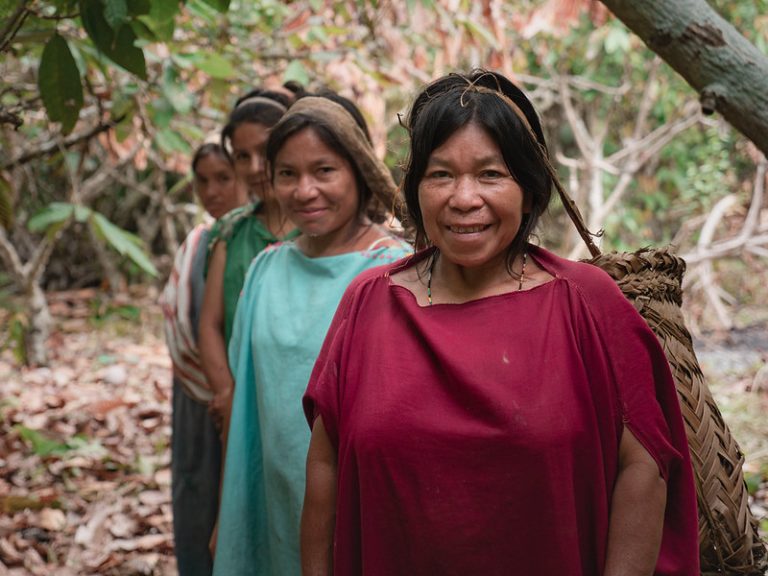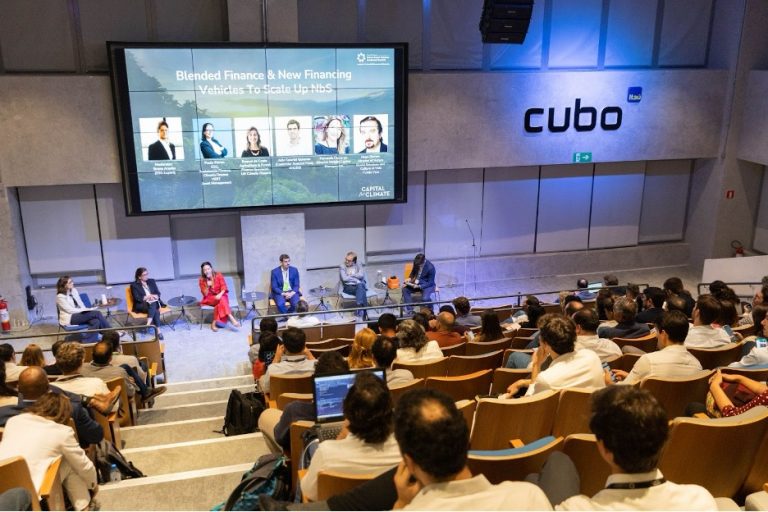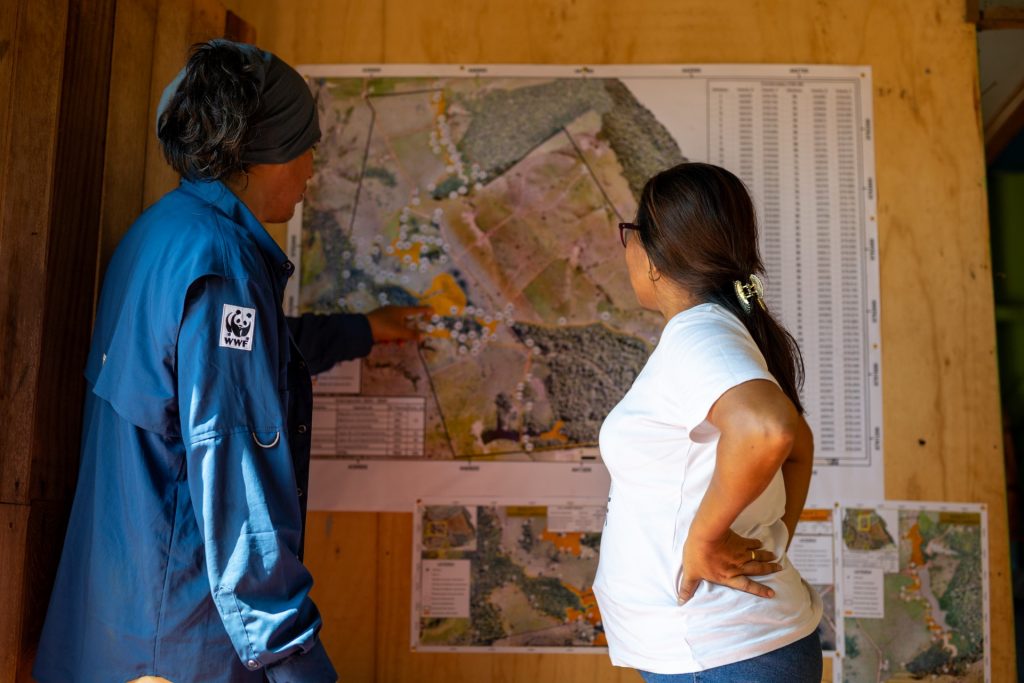This is the third blog in our three-part series about Cisco Foundation partner organizations working in the Amazon and South America region. You can read the other two, and more Climate Impact & Regeneration blogs here! This series introduces you to eight Cisco Foundation partner organizations working to support the preservation and protection of the Amazon basin through three main avenues, all of which are deeply entangled and in tandem, serving to promote enduring environmental protection and preservation: Prioritizing Indigenous Sovereignty, Promoting Sustainable Livelihood Opportunities, and Scaling Innovative Financing Opportunities.
This blog was constructed in partnership with my colleagues at WWF: Cat Normile and Hillary Wilson; Capital for Climate: Deborah Stern; NESsT: Kirsten Dueck and Tiana Lins; and Cisco: Julie Rose.
The Amazon Rainforest, an immense and biodiverse ecosystem that spans seven million square kilometers in South America, plays a crucial role in regulating the planet’s climate by absorbing carbon dioxide, releasing oxygen, and regulating global rainfall patterns. Despite the need for lasting conservation and widespread restoration, this unique biome is still under severe threat from deforestation, mining, agriculture, and climate-change induced droughts. The Amazon is intrinsically important for its unique cultural and biological diversity, and its protection can contribute to global goals, such as The Paris Agreement, to limit warming to 1.5°C above pre-industrial levels, and the Kunming-Montreal Global Biodiversity Framework.
Recognizing the urgency of the situation, climate finance has been identified as a key driver of restoration and conservation at a large scale, and yet the annual financial investment will need to increase 3x to meet 2030 targets. Specifically, funders like the Cisco Foundation are driving innovations by catalyzing and supporting public and private sector investments, emerging markets, and instruments like the voluntary carbon market and biodiversity credits.
In service to Cisco and the Cisco Foundation’s vision of a connected, regenerative, and inclusive future, we have prioritized supporting innovative financing flows to unlock resources that are so vitally needed to build economic, biocultural, and ecosystem resilience across the Amazon. We are pleased to introduce three more Cisco Foundation partner organizations that are supporting broad-level systemic change for channeling global finance mechanisms toward this region.
NESsT: Investing in social enterprises
NESsT invests in the people behind emerging market social enterprises that are using the tools of business to address the social, economic, and environmental challenges of our time. Through business acceleration and direct investment (grants, recoverable grants, and loans), NESsT serves as a catalyst to address areas often overlooked by other investors and donors. NESsT’s aim is twofold: firstly, to assist companies in addressing critical needs, and secondly, to facilitate their ability to attract additional funding. Since 1997, NESsT has accelerated 243 enterprises, creating over 112,000 jobs and impacting 1.7M+ people in Central Europe and South America.
Over the last decade, amidst growing global attention on environmental conservation, the Amazon bioeconomy has emerged as a vibrant economic sector. However, mainstream economic definitions often overlook the vital role Indigenous peoples and local communities play in environmental stewardship and economic development. NESsT takes a different approach, viewing environmental impact and sustainability through the lens of local communities. In partnership with Cisco Foundation and international supporters with a focus on the Amazon, NESsT has invested in over 50 high-impact enterprises and cooperatives, providing tailored capital solutions. These initiatives range from Indigenous-led cooperatives supporting Amazon River fishers to early-stage tech companies advancing climate solutions in the rainforest. NESsT prioritizes the voices of Indigenous and local communities, recognizing the effectiveness of their solutions and involving them in key decision-making processes.
Building on emerging learning, NESsT is developing forward-facing recommendations outlining what is necessary to create an enabling funding environment that fosters the full potential of low environmental impact economic activities. The NESsT Amazonia Initiative thus acts as a vital link between enterprises and the international finance community, facilitating the flow of appropriate financing into the Amazon region.

Capital for Climate: Mobilizing capital for Brazil’s nature-based solutions
Capital for Climate provides investors with the information they need to discover climate-related and nature-based opportunities, invest with confidence, and build effective capital allocation strategies aligned to global agreements. Capital for Climate’s initial focus is on facilitating investment into nature-based solutions (NbS), which are solutions that utilize natural ecosystems to mitigate and/or adapt to the effects of climate change. Capital for Climate describes NbS as “mission critical,” setting them as a top priority because they represent more than a third of global emissions reductions potential, and have the potential to create massive economic value. Companies and investable funds within the NbS space have already begun to flourish in Brazil, but critical barriers that thwart much-needed scale-up and rapid deployment still exist.
One of Capital for Climate’s keystone programs mitigating these challenges is the community of practice: Brazil’s Nature Based Investment Collaborative, which has a goal of attracting USD$5 billion to the sector in time for COP30 in Brazil in order to scale NbS to millions of hectares by 2030 – essential for providing economic alternatives to business-as-usual rampant deforestation. The Collaborative brings together leading investors to address critical barriers, exchange opportunities, and drive investment into key areas including regenerative agriculture, ecosystem restoration, restoration of degraded farm and pastureland, and non-timber forest bioeconomy products.
Powering this effort, and supported by the Cisco Foundation, is Capital for Climate’s NbS Investment Intelligence Platform, which outlines investable climate-related opportunities as well as contextual intelligence that is required for investor learning, strategy formation, opportunity sourcing, and diligence. The platform currently profiles 130+ investable opportunities in Brazil alone, 25+ of which are being showcased to international and regional investors through virtual roadshows and in-person summits. Cisco Foundation support is enabling the extension of this platform to broader Latin America, Africa, and Asia.
Through Capital for Climate’s strategic focus on unlocking investment flows for the Amazon and across the globe, the private sector is equipped with the knowledge and community required to invest equitably and efficiently into resilient ecosystems.

WWF: Setting a global benchmark in measuring impact
WWF has embarked on a groundbreaking journey with the establishment of the Nature-Based Solutions Origination Platform (NbS-OP) as a new model for scaling up, aligning, and mobilizing public and private finance for high-quality nature-based solutions under an integrated landscape finance approach. The NbS-OP sets a new standard for credibility and introduces standardized metrics for implementing nature-based solutions. With any such intervention, it’s critical to monitor impact and opportunities for continuous learning and improvement.
The NbS Origination Platform is piloting such a monitoring framework in Madre de Dios, a rainforested region of Peru known for its rich biodiversity, unique ecosystems, and social, economic, and cultural benefits. This implementation will lay the groundwork for monitoring across other landscapes where the NbS-OP will be operational in its early stages. By applying methodologies and principles in the diverse and ecologically rich landscape of Madre de Dios, the program aims to refine the NbS-OP’s strategies and techniques, ensuring they are robust, scalable, and adaptable to different environmental contexts. This approach seeks to truly bridge the gap between theoretical conservation models and practical, on-the-ground applications.
A key element of the program is to create robust protocols for metrics that accurately reflect impacts on nature, climate, and communities. This process involves the careful design, trial, and refinement of measurement techniques capable of capturing the diverse effects of nature-based solutions. The challenge is to establish protocols that are scientifically rigorous yet practical and flexible enough for application across various landscapes and ecosystems.
The development of these metrics goes beyond just numerical data; they will capture the holistic effect of successful nature-based solutions and will incorporate additional cutting-edge data from environmental DNA analysis, forest scanning systems, biomass monitoring, and will assess social impacts. The objective is to facilitate the creation of a comprehensive results framework for both the overarching landscape strategy and specific interventions.

The Cisco Foundation’s support for the Amazon bioregion
Whether by funding innovative financing mechanisms for greater capital flow into the region, supporting sustainable livelihood opportunities for community empowerment and ecological regeneration, or explicitly empowering Indigenous communities to practice self-governance and land defense, the Cisco Foundation is proud to support a robust suite of nonprofit partners. Through investing in resilient ecosystems, we can help protect human rights, empower vulnerable communities, and protect the planet.
Share:

